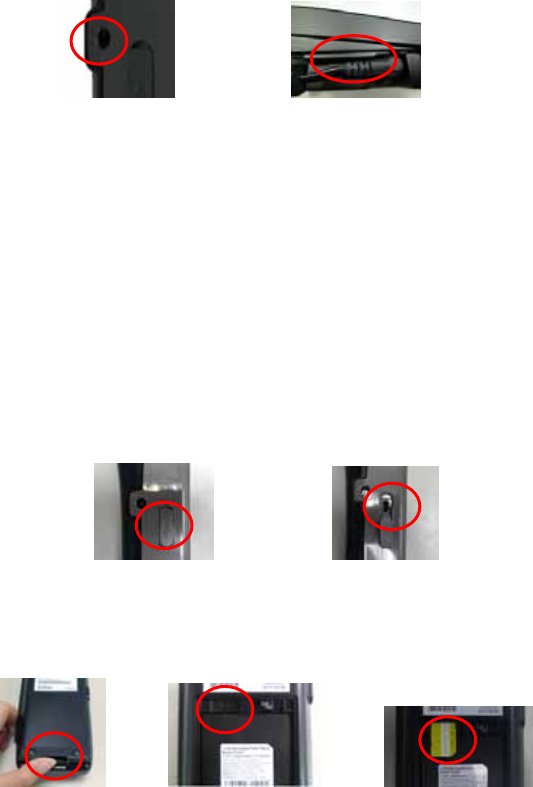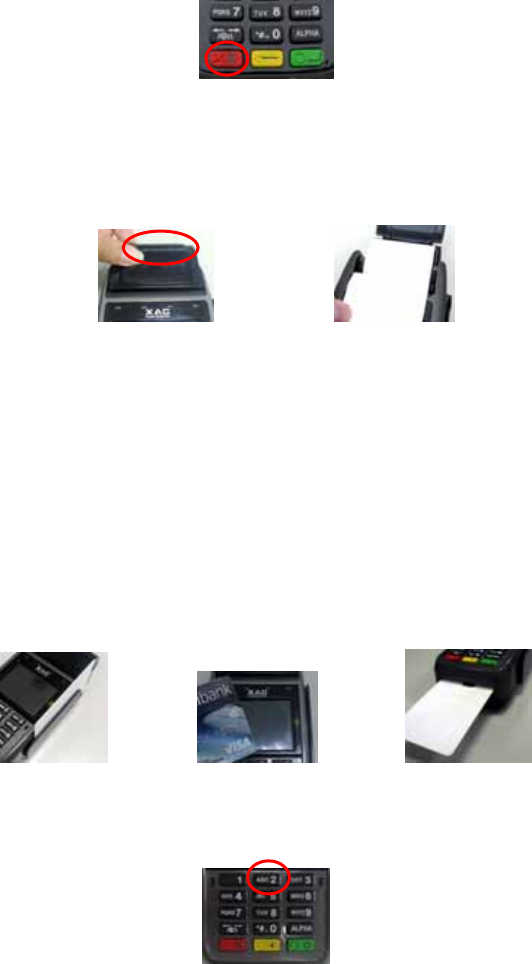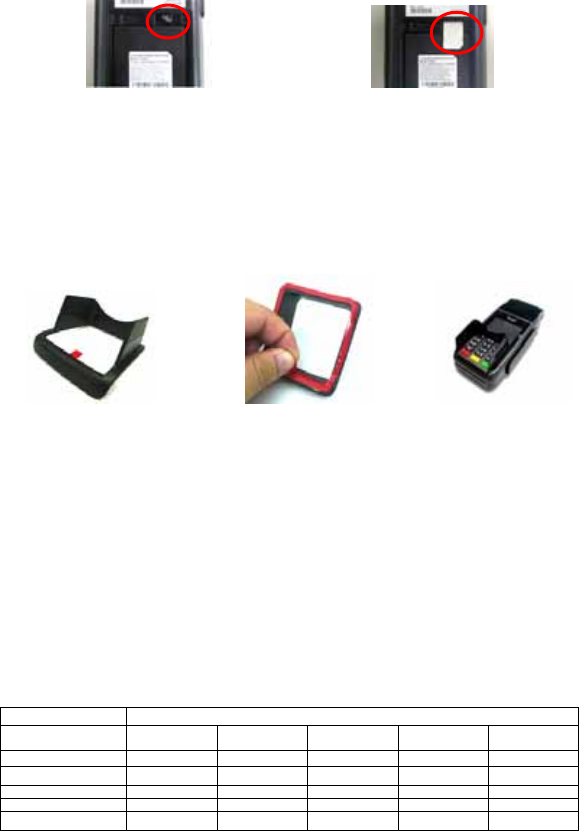XAC Automation XAPT103PUWT Terminal User Manual
XAC Automation Corporation Terminal
User Manual rev

ALL IN ONE PAYMENT TERMINAL
INSTALLATION GUIDE
MODEL:
xAPT-103PUW
xCE_T103PUW
FD410

1. BEFORE STARTING
The power input is on the left side of the terminal (Figure 1). Connect the plug from the power
adapter into the power input (Figure 2). Plug the power adapter into a 120-volt electrical outlet or
into a surge suppressor (recommended) after the power cord is connected to the power adapter.
Figure 1 Figure 2
Adapter spec:
Input: 100-240Vac, 50/60Hz 1A Output: 12Vdc, 3A
RTC battery spec.: 3V, CR2032
Operating Temperature: 0 °C to 40 °C
Caution: The cover (Figure 5) shall be provided with a means to keep it closed during normal
operation.
Caution: Risk of explosion if the battery is replaced by an incorrect type. Please dispose of used
battery according to the instructions.
Warning: A shielded-type power cord is required in order to meet FCC emission limits and also
to prevent interference to the nearby radio and television reception. It is essential that only the
supplied power cord be used.
This terminal supports one USB port. The USB host port locates on the left side of the terminal
with a protected cover (Figure 3). If the terminal uses a peripheral device with USB connector,
plug it into the USB host port (Figure 4).
Figure 3 Figure 4
(Optional) The terminal supports for a variety of wireless communications to host machine (M2M)
including GSM 3G technology, Wi-Fi, and 3G+Wi-Fi combo solution. Open the battery
compartment cover behind the device (Figure 5), and find the SIM card slot on the right side of
the terminal (Figure 6). Insert the SIM card into the SIM card slot to communicate with GSM/3G
(Figure 7). Make sure SIM card is inserted in the right direction.
Figure 5 Figure 6 Figure 7
2. POWER ON THE TERMINAL
Plug the power cord into the power jack and plug the power adapter into a 120-volt electrical
outlet or into a surge suppressor (recommended) after the power cord is connected to the power
adapter. Press the “Cancel” button at the front of device (Figure 8) until the system is booted up.

Figure 8
3. LOADING THE PAPER
Gently pop the printer cover’s latch to open the cover (Figure 9); then lift the cover. Load a roll of
thermal paper (Appleton 1012 recommended) into the printer (Figure 10). Load it so that the
print-side of the paper will feed out facing the operator. Close the cover by pressing down evenly
on both side tabs, or by pressing on the center of the printer cover. Use the serrated bar to tear off
any excess paper.
Figure 9 Figure 10
4. USING THE CARD READER
Magnetic Card Reader
Find the card reader slot at the right side of terminal. Slide the card in either direction through the
slot without stopping. If the card swipe fails, check the position of the magnetic stripe and slide
the card again (Figure 11).
Contactless Card Reader
Contactless reader antenna is around the display and PIN pad. It will light up with blue color
signal when terminal is powered on and that means reader is working normally. Put contactless
card to approach the antenna of card reader (Figure 12) for reading the card data during
transaction.
Smart Card Reader
The Integrated Circuit Card (ICC) reader is located at the most bottom end (Figure 13). Please
make sure that ICC side is facing upward when inserting into the slot.
Figure 11 Figure 12 Figure 13
5. USING THE KEY PAD
To enter numbers or letters, simply press the appropriate key. For example, to type the letter B:
Press and release [B] twice times, and then the screen displays “B” (Figure 14).
Figure 14
6. INSTALLING THE SAM CARD
Open the battery compartment cover behind the device (Figure 15), and find the SAM card slot on
the right side of the terminal (Figure 16). Before insert the SAM card, please turn off the device.
Insert the SAM card in the slot as figure. Make sure the SAM card is inserted in the right direction
(Figure ).

Figure 15 Figure 16
7. INSTALLING THE PRIVACY SHIELD
The privacy shield of the T103P shows as figure 18. We need to tear the tap around the privacy
shield (Figure 19), and please stick the privacy shield on around the 15-key keypad (Figure 20).
The terminal is compliant with PCI privacy screen design requirement when the detachable
privacy shield is installed on the device. Any change to or removal of this privacy shield will
cause security concerns.
Figure 18 Figure 19 Figure 20
Caution: When removing bottom cover for the purposes of cable or SAM card installation, remember to reinstallation the protective cover and make sure to keep
it in place.
Caution: Risk of explosion if the battery is replaced by an incorrect type. Please dispose of used battery according to the instructions.
Warning: This is a Class A product. In a domestic environment this product may cause radio interference in which case the user may be required to take
adequate measures.
Warning: If the device, T103, is used without the detachable privacy shield, the following criteria needs to be met by the Installed Environment of the PED for
complying with the PCI privacy screen design requirement:
A. Positioning of the PED on the check-stand in such way as to make visual observation of the PIN-entry process infeasible.
Visual shields designed into the check-stand.
Position the PED so that it is angled in such a way to make PIN spying difficult.
B. Pop-up (temporary) privacy shield attached to the PED mounting stand. Consumer (through education & prompting) or merchant would put the
shield in place during PIN entry.
C. Installing PED on an adjustable stand that allows consumers to swivel the terminal sideways and/or tilt it forwards/backwards to a position that
makes visual observation of the PIN-entry process difficult.
D. Positioning of in-store security cameras such that the PIN-entry keypad is not visible.
E. Instructing the cardholder regarding safe PIN-entry, done with a combination of:
Signage on the PED.
Prompts on the display, possibly with a "click-through" screen.
Potentially literature at the point of sale.
A logo for safe PIN-entry process.
Table A1: Matrix of Observation Corridors and PIN Protection Method
Observation Corridors
Method Cashier
Customers
in Queue Customers
Elsewhere On-Site
Cameras Remote
Cameras
PED Stand A M H L L L
PED Stand B H H H L M
Check-Stand A L M M L H
Check-Stand B H H M H H
Customer Instruction H* H* H* H* H*
z Customer Instruction methods are less repeatable and therefore should be used in combination with other methods. L = low, M = medium, H =
high.
Caution: Use only shielded signal cables to connect I/O devices to this equipment. You are cautioned that changes or modifications not expressly approved by the
party responsible for compliance could void your authority to operate the equipment.
This device complies with Part 15 of the FCC Rules. Operation is subject to the following two conditions: (1) This device may not cause harmful interference, and (2)
this device must accept any interference received, including interference that may cause undesired operation.
Federal Communication Commission Interference Statement
This device complies with part 15 of the FCC Rules. Operation is subject to the following two conditions:
(1) This device may not cause harmful interference, and
(2) this device must accept any interference received, including interference that may cause undesired operation.
This equipment has been tested and found to comply with the limits for a Class A digital device, pursuant to part 15 of the FCC Rules. These limits are designed to
pro-vide reasonable protection against harmful interference when the equipment is operate din a commercial environment. This equipment generates, uses, and
can radiate radiofrequency energy and, if not installed and used in accordance with the instruction manual, may cause harmful interference to radio
communications. Operation of this equipment in a residential area is likely to cause harmful interference in which case the user will be required to correct the
interference at his own expense.
FCC Caution: Any changes or modifications not expressly approved by the party responsible for compliance could void the user's authority to operate this
equipment.

IMPORTANT NOTE:
FOR PORTABLE DEVICE USAGE (<20m from body/SAR needed)
Radiation Exposure Statement:
The product comply with the FCC portable RF exposure limit set forth for an uncontrolled environment and are safe for intended operation as described in this
manual. The further RF exposure reduction can be achieved if the product can be kept as far as possible from the user body or set the device to lower output power if
such function is available..
Industry Canada Statement
This device complies with RSS-210/247/132/133 of the Industry Canada Rules. Operation is subject to the following two conditions:
(1) this device may not cause interference and
(2) this device must accept any interference, including interference that may cause undesired operation of the device
Ce dispositif est conforme à la norme CNR-210/247/132/133 d'Industrie Canada applicable aux appareils radio exempts de licence. Son fonctionnement est sujet
aux deux conditions suivantes:
(1) le dispositif ne doit pas produire de brouillage préjudiciable, et
(2) ce dispositif doit accepter tout brouillage reçu, y compris un brouillage susceptible de provoquer un fonctionnement indésirable.
IMPORTANT NOTE: IC Radiation Exposure Statement:
This equipment complies with IC radiation exposure limits set forth for an uncontrolled environment. This equipment should be installed and operated with minimum
distance 20cm between the radiator & your body.
NOTE IMPORTANTE: (Pour l'utilisation de dispositifs mobiles)
Déclaration d'exposition aux radiations:
Cet équipement est conforme aux limites d'exposition aux rayonnements IC établies pour un environnement non contrôlé. Cet équipement doit être installé et utilisé
avec un minimum de 20 cm de distance entre la source de rayonnement et votre corps.
Warning: This is a Class A product. In a domestic environment this product may cause radio interference in which case the user may be required to take adequate
measures.